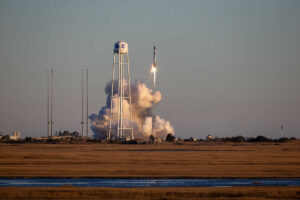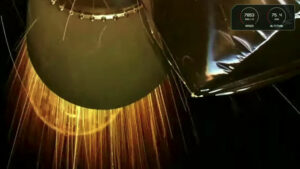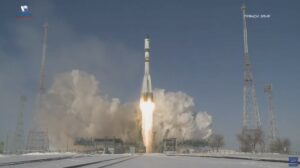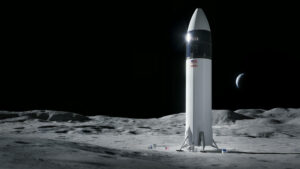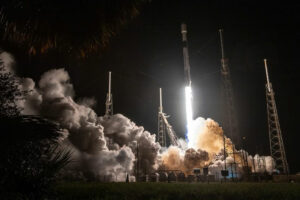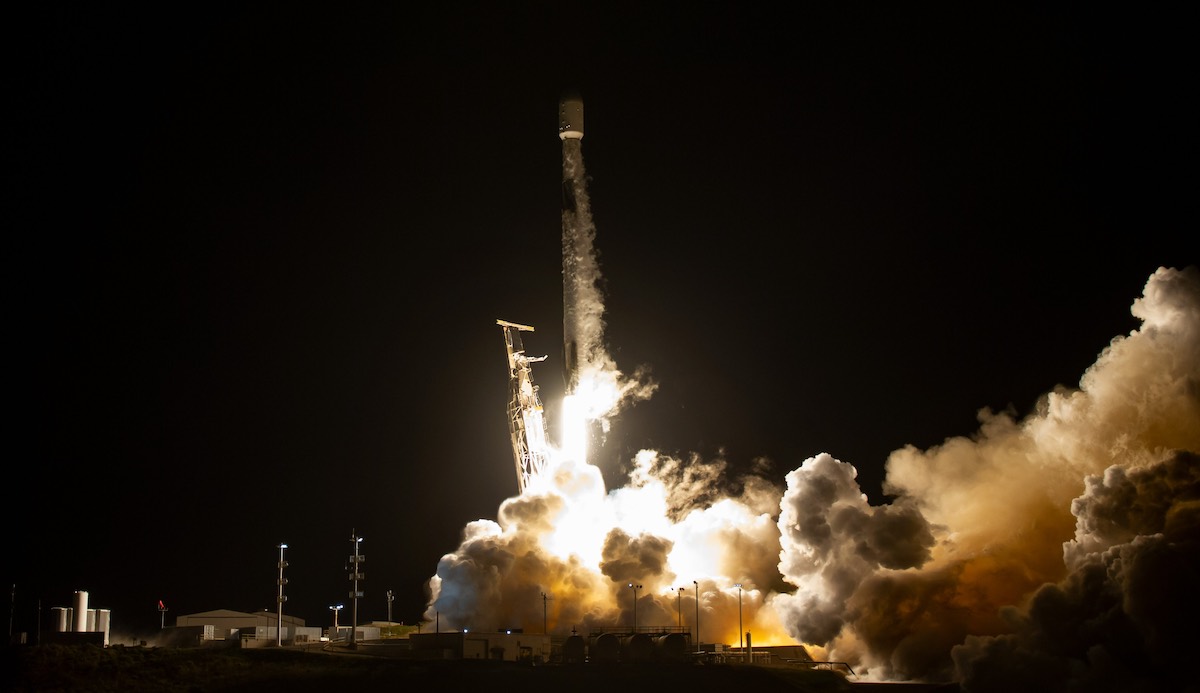
Another batch of 52 Starlink satellites launched late Tuesday from Vandenberg Space Force Base in California, on the way to join SpaceX’s fleet of more than 4,000 spacecraft beaming broadband signals around the world.
Stacked one on top of the other inside the payload fairing of a Falcon 9 rocket, the 52 satellites lifted off from Space Launch Complex 4-East at Vandenberg at 11:02:30 p.m. PDT Tuesday (2:02:30 a.m. EDT; 0602:30 UTC Wednesday).
Nine kerosene-fueled Merlin engines throttled up to produce 1.7 million pounds of thrust to power the 229-foot-tall (70-meter) Falcon 9 rocket into space from California’s Central Coast. The rocket’s first stage, flying for the 14th time, shut down its engines and dropped away from the Falcon 9’s upper stage about two-and-a-half minutes into the mission.
The upper stage ignited a single engine to accelerate the 52 Starlink satellites to orbital velocity, then released the spacecraft into orbit about 17 minutes after liftoff. SpaceX declared success on the launch, the 200th consecutive flawless flight of a Falcon rocket, and the 206th straight successful launch of the company’s Falcon rocket family, including Falcon Heavy missions.
The first stage, designated B1062 in SpaceX’s fleet, extended aerodynamic grid fins and reignited its engines to slow for landing on a drone ship in the Pacific Ocean east of Baja California.
The guidance computer on the second stage of the Falcon 9 aimed to place the 51 Starlink payloads into an orbit between 138 miles and 207 miles (222-by-333 kilometers) above Earth. Tuesday night’s mission, designated Starlink 2-10 in SpaceX’s mission sequence, targeted an orbit inclined 70 degrees to the equator. SpaceX confirmed the rocket reached the expect orbit with the Starlink satellites.
The mission deployed the 52 Starlink satellites into Group 2 of the constellation.
SpaceX’s first-generation Starlink fleet is spread out into five groups, or orbital shells, between 335 miles and 354 miles in altitude. The first-generation Starlink shells are inclined at different angles to the equator, with some satellites orbiting between 53 degrees north and south latitude, and others in orbits flying from pole-to-pole.
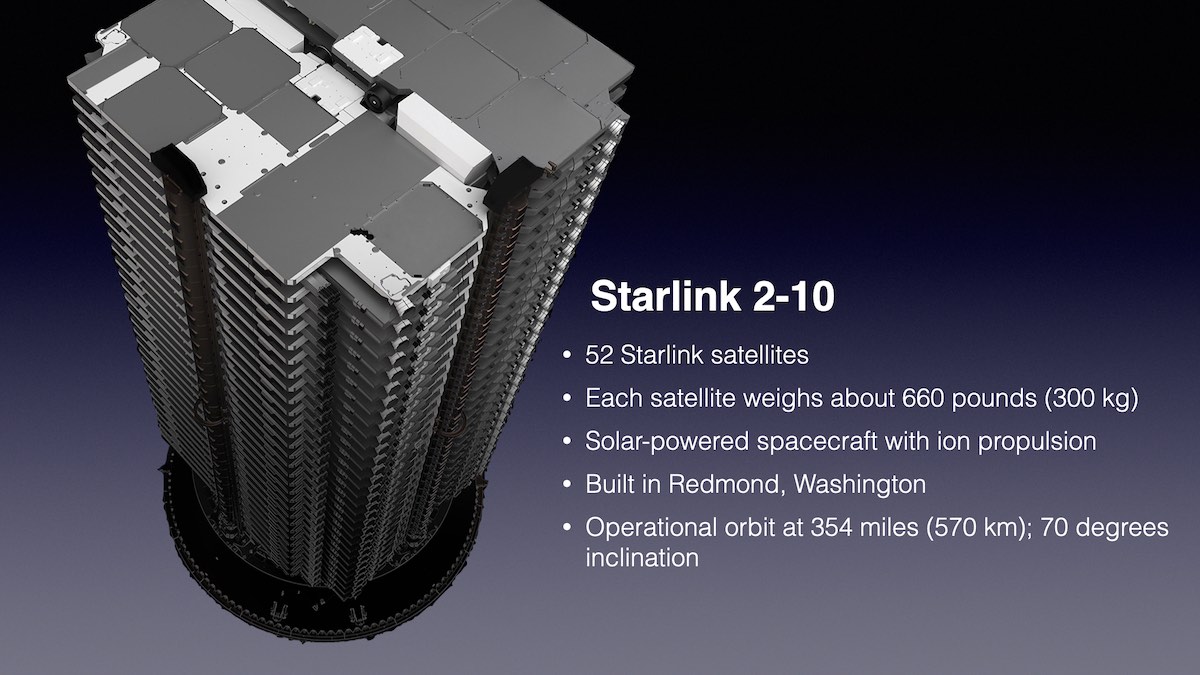
SpaceX began launching older-design satellites, called Starlink V1.5, into its second-generation Starlink constellation, called Gen2, in December. The first batch of upgraded, larger Starlink satellites launched in February from Cape Canaveral. But the Starlink 2-10 mission continued filling out the first-generation Starlink fleet with another batch of satellites built on the previous Starlink V1.5 design.
The 52 Starlink internet satellites on-board Tuesday night’s Falcon 9 mission brought the total number of Starlink spacecraft launched to 4,521.
The Federal Communications Commission granted SpaceX approval Dec. 1 to launch up to 7,500 of its planned 29,988-spacecraft Starlink Gen2 constellation. The regulatory agency deferred a decision on the remaining satellites SpaceX proposed for Gen2.
The FCC previously authorized SpaceX to launch and operate roughly 4,400 first-generation Ka-band and Ku-band Starlink spacecraft that SpaceX has been launching since 2019.
Tuesday night’s launch was SpaceX’s 43rd launch from Vandenberg, located about 140 miles (225 kilometers) northwest of Los Angeles. It was the 11th orbital launch of the year overall from Vandenberg.
Email the author.
Follow Stephen Clark on Twitter: @StephenClark1.
- SEO Powered Content & PR Distribution. Get Amplified Today.
- PlatoAiStream. Web3 Data Intelligence. Knowledge Amplified. Access Here.
- Minting the Future w Adryenn Ashley. Access Here.
- Buy and Sell Shares in PRE-IPO Companies with PREIPO®. Access Here.
- Source: https://spaceflightnow.com/2023/05/31/spacex-delivers-52-more-starlink-satellites-into-orbit/
- :has
- :is
- ][p
- $UP
- 000
- 1
- 11
- 17
- 2019
- 30
- 500
- 7
- 70
- 9
- a
- About
- above
- accelerate
- After
- agency
- aimed
- an
- and
- Angeles
- Another
- approval
- ARE
- around
- At
- author
- authorized
- away
- base
- been
- began
- between
- broadband
- brought
- built
- but
- california
- called
- central
- Coast
- COM
- commission
- Communications
- Company’s
- complex
- computer
- CONFIRMED
- consecutive
- continued
- credit
- December
- decision
- delivered
- delivers
- deployed
- Design
- designated
- different
- down
- drone
- dropped
- earth
- East
- Engine
- Engines
- expect
- falcon
- Falcon 9
- family
- FCC
- February
- Federal
- Federal Communications Commission
- FINS
- First
- FLEET
- flight
- flying
- For
- Force
- from
- granted
- Grid
- Group
- Group’s
- guidance
- heavy
- http
- HTTPS
- in
- Inclined
- Including
- Internet
- into
- IT
- ITS
- join
- jpg
- landing
- larger
- Late
- latitude
- launch
- launched
- launching
- Lifted
- located
- los
- Los Angeles
- max-width
- merlin
- million
- minutes
- Mission
- missions
- more
- North
- number
- ocean
- of
- off
- on
- ONE
- operate
- or
- Orbit
- orbiting
- Other
- Others
- out
- overall
- Pacific
- Pacific Ocean
- Place
- planned
- plato
- Plato Data Intelligence
- PlatoData
- pounds
- power
- previous
- previously
- produce
- proposed
- reached
- regulatory
- released
- remaining
- rocket
- roughly
- satellites
- Second
- Sequence
- Shut down
- signals
- since
- single
- slow
- some
- South
- Space
- Space Force
- spacecraft
- spaceflight
- SpaceX
- spread
- Stage
- starlink
- Stephen
- straight
- success
- successful
- targeted
- than
- that
- The
- the world
- then
- time
- to
- top
- Total
- Tuesday
- upgraded
- UTC
- v1
- VeloCity
- was
- Way..
- Wednesday
- with
- world
- year
- zephyrnet


